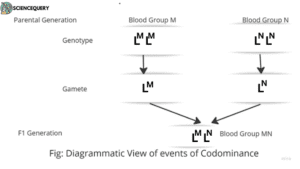
Introduction
Gregor Mendel achieved a breakthrough with his experiments in the field of Genetics. However, he generally worked on a controlled setup. His laws applied to many of the plants. But, after replacing the pea plants with Arabidopsis thaliana or Zea mays, scientists found that they were not following Mendel’s laws. This inconsistency was assessed by two scientists, Bateson and Hugo de Vries. These are called as Non-Mendelian Inheritance.
Definition
Non-Mendelian Inheritance is any pattern of characters inheriting those who do not follow Mendelian laws.
- A single gene controlled the characters Mendel studied.
- Each parent passed one allele to the child.
- However, a few characteristics are controlled by more than one allele. Not always the dominant traits are visible.
- These are all part of non-Mendelian inheritance.
Importance of Mendel’s law of inheritance
Gregor Mendel was the first one to identify the actual path of heredity. Earlier, biologists used to believe in a blended pathway of heredity. Mendel was the first one to advocate that characters come from parent to child in pairs but independently. Mendel’s laws tell us-
- Why do the characters in offspring vary from parents?
- The dominant and recessive forms of characters.
- The phenotypic appearance of characters
Law of dominance
This dominance law states that only dominant phenotypic qualities will pass down to hybrid offspring.
Recessive characteristics are those alleles that are suppressed, whereas dominant traits are those alleles that control the trait. Both the dominant and recessive characters of the parent are purebred.
Law of segregation
This one is known as the first law of Mendel’s law of inheritance. According to this law of segregation, each hereditary factor separates into two copies during the formation of gametes. This allows the offspring to inherit one copy from each parent.
In simple words, during the development of the gamete, the allele pairs separate first. Then they randomly re-unite. The results of the monohybrid cross experiment led to this law.
Law of Independent Assortment
The law of independent assortment is commonly known as Mendel’s second law of inheritance. This stipulates that during gamete production, a pair of characteristics segregates independently of another pair.
As the separate heredity variables assort independently, many phenotypes have an equal chance to occur simultaneously. So, the allele pair reunites in all possible combinations. This law is particularly derived from Mendel’s experiment of the dihybrid cross.
Non-Mendel inheritance patterns
We have already discussed what non-Mendelian inheritance is. But now we will focus on different patterns of this inheritance. These patterns either include a single gene or include multiple genes.
Patterns with a single gene are incomplete dominance and codominance. Polygenic inheritance is an example of a pattern having multiple genes.
Now, let’s discuss these patterns.
Incomplete dominance

When both alleles of a gene are only partially expressed at a locus, it is known as incomplete dominance. This sort of gene interaction frequently produces an intermediate or distinct phenotype. Additionally called partial dominance.
Given that none of the two alleles is entirely dominant over the other, incomplete dominance results. This leads to a phenotype that combines both of them. In this instance, heterozygotes who obtain both alleles have an intermediate phenotype.
In Mirabilis jalapa or Nine o’Clock, we can find this phenomenon. When a pure red flower is crossed with a pure white flower, a pink flower is produced in the F1 generation. Neither the red flower nor the white flower expresses the dominant trait.
Phenotypic ratio = red : pink : white = 1 : 2 : 1
Genotypic ratio = RR : Rr : rr = 1 : 2 : 1
Codominance

Co-dominance is a form of dominance caused by the mixing of genes in which the children exhibit similar traits to both parents. Codominance refers to the occurrence of both paternal traits in the F1 generation. The child will have traits from both parents. When two alleles of a gene are expressed equally in the phenotypic of heterozygotes, codominance develops.
MN blood group is great evidence of Codominance. MN blood group is expressed by two alleles LMLN. If a person has an M blood group, the genotype will be LMLM. LNLN is the genotype for the N blood group. Suppose, the parents have M and N blood groups respectively. Then the child will have MN blood type with LMLN genotype.
Multiple Alleles
It is believed that most human genes have more than two alleles or normal variants. Multiple allele traits are those caused by a single gene that has more than two alleles.
Humans with ABO blood types are one example. The gene that determines this trait has three prevalent alleles. A, B, and O stand for these three most prevalent alleles.
Due to the three alleles’ ability to be combined in six different ways when taken in pairs, six different ABO genotypes can exist, as illustrated in the table. The O allele is subordinate to the A and B alleles. Due to the presence of the A antigen in their blood (type A blood), both AA and AO genotypes exhibit the same phenotype. The B antigen is present in type B blood, and both the BB and BO genotypes share this characteristic. People with the OO genotype lack the ABO blood type antigens (type O blood) because the O allele is not connected with any antigens.
Polygenic Inheritance
More than one gene is responsible for controlling several human features. They are referred to as polygenic characteristics. Each gene’s allele has a negligible additive influence on the phenotype. Particularly if each gene contains many alleles, there are numerous potential allele combinations. As a result, a wide range of phenotypes is feasible.
A good example of polygenic inheritance is the skin color of humans. According to Davenport, 20 genes control the skin color of humans.
Epistasis
When two genes interact in epistasis, they do so in an antagonistic way: one gene hides or obstructs the expression of the other. The word “epistasis” derives from Greek roots that imply “standing upon.”
The epistatic alleles that are masking or silencing, alleles that are being masked or silenced are referred to as hypostatic. A gene pathway in which the expression of one gene depends on the function of a gene that comes before or after it in the pathway is frequently the biochemical basis of epistasis.
Epistasis is exemplified by albinism. A person with albinism has almost no skin pigment. The disorder is caused by a completely different gene than those that determine skin tone. Tyrosinase, a protein required for the creation of healthy skin pigment, is not created as a result of a gene mutation, which results in albinism. Regardless of the skin color genes that were inherited, a person with the albinism mutation will not have any skin pigment.
Genomic Imprinting
Through a process called genomic imprinting, genes are silenced. The active allele is unmethylated, whereas the repressed allele is. Genomic imprinting happens when two alleles at a locus are not functionally comparable. It is thought to be the main epigenetic mechanism (epigenetic means the factors beyond genetic codes) that might cause parental effects to appear.
Since genomic imprinting affects both male and female offspring, it results through parental inheritance rather than from sex. At various stages of life, environmental variables can cause epigenetic alterations. DNA, histones, and nucleosomes are the three main levels on which epigenetic regulation occurs. Epigenetic mechanisms play a crucial role in brain development and the long-lasting impacts of environmental signals on the prenatal and postnatal brain. They encode information above and beyond the DNA sequence.
Applications
Using non-Mendelian inheritance, a hybrid species can be formed. For example, the mule is produced by crossing a male donkey and a female horse. Sickle cell anemia causes mutation in red blood cells. The nucleus becomes semilunar in shape. However, Plasmodium vivax, a malaria malaria-causing organism can not attack such a nucleus. Hence, people having sickle cell anemia have a better survival rate against malaria. This is an example of pleiotropy.
Q&A
1. What is non-Mendelian Inheritance?
The inheritance pattern that deviates from Mendel’s laws is the subject of non-mendelian genetics. The inheritance of features connected to a single gene on chromosomes is described. Any pattern in which traits do not segregate in line with Mendel’s rules is referred to as non-Mendelian inheritance.
2. What is non-Mendelian genetics?
Non-Mendelian genetics is the study of those patterns of inheritance that do not follow Mendel’s laws. The inheritance of features connected to a single gene on chromosomes. The scientists discovered various features that defy Mendel’s principles as they investigated an increase in the number of test crossings.
3. How does non-Mendelian inheritance help diversity?
The incomplete dominance in Mirabilis jalapa gives rise to a new pink flower. Mule is a product of codominance. Mule bears characters of both horse and donkey. If we practice experiments based on non-Mendelian inheritance, we can produce a new organism with different characteristics.
4. How to solve non-Mendelian inheritance?
To solve Non-Mendelian inheritance we have to keep in mind that here
5. Why non-Mendelian inheritance is important?
Many medical procedures and processes depend on non-Mendelian inheritance. Offspring can carry the qualities of both their parents in a mixed format rather than being genetically identical to them due to non-Mendelian inheritance. It tells us the reasons behind skin color, albinism, sickle cell anemia, etc.
Summary
- Non-Mendelian inheritance is the pattern of characters that do not follow Mendelian laws of inheritance.
- According to Mendel, each character is expressed by a single gene. However, it was found that many characters are there which are expressed through multiple genes.
- Mendel proposed three laws of inheritance. These are the law of dominance, the law of segregation, and the law of independent assortment.
- Incomplete dominance, codominance, multiple alleles, epistasis, and polygenic inheritance all are examples of non-Mendelian inheritance patterns.
- These patterns either include single genes or multiple genes. Incomplete dominance, codominance, and multiple alleles come under the patterns including single genes.
- Incomplete dominance is a state where the dominant character can not express completely over recessive one. Thus, a completely new character is expressed in offspring.
- In codominance, a mixture of dominant and recessive characters is expressed in offspring. Multiple alleles are almost the same as codominance but the character is controlled by more than two alleles.
- Our skin color is controlled by 20 genes. This phenomenon is known as polygenic inheritance.
References
- https://www.ncbi.nlm.nih.gov/pmc/articles/PMC9252483/
- https://humanbiology.pressbooks.tru.ca/chapter/5-13-non-mendelian-inheritance/#:~:text=Non%2DMendelian%20inheritance%20refers%20to,two%20alleles%20and%20complete%20dominance%20.
